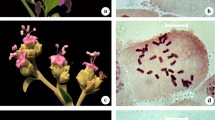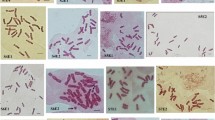Abstract
In this study, the somatic chromosome numbers and karyotype analyses were determined for nine taxa that belong to three different genera of Senecioneae tribe. The studied taxa are; Senecio tauricolus V.A.Matthews, Senecio racemosus (M.Bieb.) DC., Senecio paludosus L., Senecio trapezuntinus Boiss., Senecio inops Boiss. & Balansa subsp. inops, Turanecio pandurifolius (K.Koch) Hamzaoğlu, Turanecio hypochionaeus (Boiss.) Hamzaoğlu, Turanecio eriospermus (DC.) Hamzaoğlu, Tephroseris integrifolia (L.) Holub. subsp. aurantiaca (Hoppe ex Willd.) B.Nord. S. tauricolus, S. trapezuntinus, S. inops subsp. inops and T. hypochionaeus taxa are endemic to Turkey. The chromosomal variability in the tribe Senecioneae has observed the existence of four chromosome numbers: 2n = 38, 2n = 40, 2n = 46 and 2n = 80. The chromosome number 2n = 38 is a new record for Turanecio species. All taxa existed karyotypes measured by a set of median to submedian chromosomes and a smaller number of subterminal chromosome pairs. Also their karyotype asymmetry indices (TF %, As K %, Syi, Rec, A, A 1 and A 2) were calculated. The ideograms and detailed chromosome morphology measurements of the species were performed by the use of image analysis system (Bs200Pro). This is the first account of somatic chromosomes and karyotypes for the studied taxa except for S. paludosus. The research has contributed to the taxonomic revision of the tribe, Senecioneae, in Turkey.




Similar content being viewed by others
References
Açıkbaş S (2009) Endemik Senecio L. (Asteraceae) Taksonlarının Gövde ve Yaprak Anatomisi. Yüksek Lisans Tezi. Ankara Üniversitesi. Fen Bilimleri Enstitüsü, Ankara
Arano H (1963) Cytological studies in subfamily Carduoideae (Compositae) of Japan. IX. The karyotype analysis and phylogenic considerations on Pertya and Ainsliaea. Botanical Mag (Tokyo) 76:32–39
Bain JF (1985) Chromosome numbers in the aureoid Senecio complex (Asteraceae). Canad J Bot 63:539–542
Beck E, Scheibe R, Schlütter I, Sauer W (1992) Senecio x saundersii Sauer & Beck (Asteraceae), an intermediate hybrid between S. keniodendron and S. keniensis of Mt. Kenya. Phyton (Horn) 32:9–37
Beuzenberg EJ (1975) Contributions to a chromosome atlas of the New Zealand flora—17. Senecio (Compositae). N Z J Bot 13:345–353
Bremer K (1994) Compositae, cladistics and classification. Timber Press, Portland
Budak Ü, Hamzaoğlu E, Aksoy A (2007) A new record for the flora of Turkey: Tephroseris cladobotrys (Ledeb.) Griseb. & Schenk (Senecioneae, Asteraceae). Turk J Bot 31:265–268
Budak Ü, Hamzaoğlu E, Aksoy A (2009) New records of Senecio L. (Asteraceae) for the flora of Turkey. Turk J Bot 33:231–233
Buttler KP (1983) Chromosomenzahlen von Gefässpflanzen aus Hessen (und dem angrenzenden Bayern). 1. Folge Hess Florist Briefe 32:23–26
Cai J, Wang H, Gu ZJ, Mill RT, Li DZ (2004) Karyotypes of thirteen species of Pedicularis (Orobanchaceae) from the Hengduan Mountains region, NW Yunnan, China. Caryologia 57:337–347
Chater AO, Walters SM (1976) Senecio L. In: Tutin TG, Heywood VH, Burges NA, Moore DM, Valentine, DH, Walters SM, Webb DA (eds), vol 4. Cambridge University Press, Cambridge Flora Europaea, pp 191–205
Comes H, Kadereit JW (1990) Aspects of hybridization between the closely related Senecio vulgaris L. and Senecio vernalis Waldst. & Kit. Flora 184:381–388
Davis PH, Tan K, Mill RR (1988) Flora of Turkey and the East Aegean Islands, vol 10. Edinburgh at the University Press, Edinburgh
Davlianidze M (1980) Numeri chromosomatum Angiospermarum Khromosomnye chisla cvetRovykh rastenij. Not Syst Geogr Inst Bot Akad Nauk Gruzinsk (Tbilisi) 36:75–76
De Lange PJ, Murray BG, Datson PM (2004) Contributions to a chromosome atlas of the New Zealand flora—38. Counts for 50 families. N Z J Bot 42:873–904
Eroğlu HE, Simşek N, Koç M, Hamzaoğlu E (2013) Karyotype analysis of some Minuartia L. (Caryophyllaceae) taxa. Plant Syst Evol 299:67–73
Gadnidze RI, Gviniashvili TN, Danelia IM, Churadze MV (1998) Chromosome numbers of the species of the Georgian flora. Bot Žhurn 83(10):143–147
Gagnidze RI, Gviniaschvili TN, Tschuradse M (1986) Numeri chromosomatum specierum nonnularum endemicarum florae Caucasi. Notul Syst Geograph Inst Bot Thbilissi 41:80–84
Gill LS (1978) New chromosome numbers in the family Labiatae. Sci Cult 44:273–274
Gill LS, Omoigui DI (1992) Chromosome numbers in some Nigerian Compositae. Compositae Newslett 20(21):12–15
Gilmer K, Kadereit JW (1989) The biology and affinities of Senecio teneriffae Schultz Bip., an annual endemic from the Canary Islands. Bot Jahrb Syst 111:263–273
Greilhuber J, Speta F (1976) C-banded karyotypes in the Scilla hohenackeri Group, S. persica and Puschkinia (Liliaceae). Plant Syst Evol 126:149–188
Hamzaoğlu E, Budak Ü, Aksoy A (2009) A new taxon of Senecio (Asteraceae) from Turkey: Senecio inops Boiss. & Balansa subsp. karamanicus Hamzaoğlu & Budak. Turk J Bot 33:285–289
Hamzaoğlu E, Budak Ü, Aksoy A (2011) A new genus, Turanecio, of the Asteraceae (tribe Senecioneae). Turk J Bot 35:479–508
Hedberg I, Hedberg O (1977) Chromosome numbers of afroalpine and afromontane angiosperms. Bot Not 130:1–24
Huziwara Y (1962) Karyotype analysis in some genera of Compositae. VIII. Further studies on the chromosome of Aster. Am J Bot 49:116–119
Janisova M, Skodova I, Hegedusova K (2012) Reproductive biology of Tephroseris longifolia subsp. moravica, an endemic taxon of European importance. Seed Sci Res 22:113–122
Kochjarova J (2005) In chromosome number and DNA ploidy level reports from central Europe—1. Biologia (Bratislava) 60(1):99–103
Kochjarová J (1997) Náčrt taxonomickej problematiky rodu Tephroseris v Západných Karpatoch. Preslia 69:71–93
Krach B (1988) Tephroseris integrifolia subsp. vindelicorum eine neue Sippe vom Augsburger Lechfeld. Mitt Bot Staatssamml München 27:73–86
Krasnikova SA, Krasnikov AA, Rostovtzeva TS, Chanminchun VM (1983) Chromosome numbers of some plant species from the south of Siberia. Bot Zhurn SSSR 68(6):827–835
Krogulevich RE (1976) Rol poliploidii v genesise flory Putorana. In: Malyshev LI (ed) Flora Putorana: Materali k Poznaniiu Osobennostei Sostava i Genezisia Gornykh Subarkticheskikh Flor Sibir. Novosibirsk
Krogulevich RE (1984) In: Krogulevich RE, Rostovtseva RS (eds) Khromosomnye Chisla Tsvetkovykh Rastenii i Sibiri Dal’nego Vostoka. Izdatel’stvo “Nauka”. Sibirskoe Otdelenie Novosibirsk ý
Kuzmanov BA, Georgieva SB, Nikolova VA (1986) Chromosome numbers of Bulgarian flowering plants. I. Fam. Asteraceae. Fitologija 31:71–74
Lavania UC, Srivastava S (1992) A simple parameter of dispersion index that serves as an adjunct to karyotype asymmetry. J Biosci 17(2):179–182
Lawrence ME (1980) Senecio L. (Asteraceae) in Australia: chromosome numbers and the occurrence of polyploidy. Aust J Bot 28:151–166
Levan A, Fredga K, Sandberg AA (1964) Nomenclature for centromeric position on chromosomes. Hereditas 52:201–220
Liu Y, Yang QR (2011) Cytology and its systematic implications in Sinosenecio (Senecioneae–Asteraceae) and two closely related genera. Plant Syst Evol 291:7–24
Lopez MG (2005) Chromosome numbers and meiotic studies in species of Senecio (Asteraceae) from Argentina. Bot J Linn Soc 148:465–474
Lotfi E, Yousofi M, Assadi M (2010) A revision of Senecio L. (Asteraceae, Senecioneae), in Iran. Iran J Bot 16(1):96–106
Love A, Love D (1975) In IOPB chromosome number reports L. Taxon 24:671–678
Lövkvist B, Hultgård UM (1999) Chromosome numbers in south Swedish vascular plants. Opera Bot 137:1–42
Magulaev AY (1982) The number of chromosomes of the species of Asteraceae, Caryophyllaceae and Plantaginaceae of the North Caucasus. Biol Nauki (Moscow) 11(227):74–79
Martin E, Duman H, Ünal F (2009) Karyological studies on section Empedoclia of Sideritis (Lamiaceae) from Turkey. Caryologia 62:180–197
Martin E, Akan H, Ekici M, Aytaç Z (2010) Karyology of ten Turkish Trigonella L. (Leguminosae) species from section Cylindricae Boiss. Turk J Bot 34:485–494
Matthews VA (1975) Senecio L. In: Davis PH (ed) Flora of Turkey and the East Aegean Islands, vol 5. Edinburgh Univ Press, Edinburgh, pp 145–168
Micelli P, Monti G (1980) Numeri cromosomici per la Flora Italiana: 787-793. Inform Bot Ital 12:327–332
Morton JK (1981) Chromosome numbers in Compositae from Canada and the U.S.A. Bot J Linn Soc 82:357–368
Mraz P (2005) In chromosome number and DNA ploidy level reports from central Europe—1. Biologia (Bratislava) 60(1):99–103
Murray DF, Kelso S (1997) Chromosome numbers and notes on the taxonomy of selected Alaskan vascular plants. Rhodora 99:33–55
Nordenstam B (1989) Senecio L. & Iranecio B.Nord. In: Rechinger KH (ed) Flora Iranica, Compositae VII, Akademische Druck- u. Verlagsanstalt Graz, Austria vol 164. pp 53–95
Nordenstam B (2006) Additions to the genus Jacobaea Mill. (Compositae, Senecioneae). Compositae Newslett 44:12–13
Nordenstam B (2007) Tribe Senecioneae Cass. In: Kubitzki (series ed) The families and genera of vascular plants, vol 8, flowering plants. Eudicots, Asterales: Kadereit J, Jeffrey C (vol eds) Berlin, Heidelberg, Springer, New York, pp 208–241
Nordenstam B, Rechinger KH (1989) Senecioneae (pars). In: Rechinger KH (ed) Flora Iranica, vol 164. Akademische Druck-u. Verlegsanstalt, Graz, pp 41–94
Özhatay N, Kültür Ş (2006) Check-list of additional taxa to the supplement Flora of Turkey III. Turk J Bot 30:281–316
Paszko A (2006) A critical review and a new proposal of karyotype asymmetry indices. Plant Syst Evol 258:39–48
Pavlova D, Tosheva A (2005) Notes on karyomorphology of Melilotus officinalis populations in Bulgaria. Caryologia 57:151–158
Pelser PB, Veldkamp JF, Van der Meijden R (2006) New combinations in Jacobaea Mill. (Asteraceae–Senecioneae). Compositae Newslett 44:1–11
Pelser PB, Nordenstam B, Kadereit JW, Watson LE (2007) An ITS phylogeny of tribe Senecioneae (Asteraceae) and a new delimitation of Senecio L. Taxon 56:1077–1104
Peruzzi L, Eroğlu HE (2013) Karyotype asymmetry: again, how to measure and what to measure? Comp Cytogen 7(1):1–9
Peruzzi L, Dawson MI, Bedini G (2011) Chromosome number variation in two antipodean floras. AoB Plants plr020 doi:10.1093/aobpla/plr020
Probatova NS (2004) Chromosome numbers of selected vascular plant species from Sakhalin, Moneron and the Kurile Islands. Biodivers Biogeogr Kuril Islands Sakhalin 1:15–23
Razaq ZA, Vahidy AA, Ali SI (1994) Chromosome numbers in Compositae from Pakistan. Ann Missouri Bot Gard 81:800–808
Romero Zarco C (1986) A new method for estimating karyotype asymmetry. Taxon 35:526–530
Rostovtseva TS (1983) Chromosome numbers of some species of the family Asteraceae II. Bot Zhurn SSSR 68(5):660–664
Schishkin BK, Bobrov EG (ed) (1961) Compositae—Senecio in Komarov flora URSS, vol 26. pp 801–908. Doon Scientific Translation co. 318, Chukhuwala, Dehra Dun, India. (English translation: 1995)
Stebbins GL (1971) Chromosomal evolution in higher plants. Edward Arnold, London
Stevens PF (2001) Angiosperm Phylogeny Website Version 8, June 2007 [and more or less continuously updated since]. http://www.mobot.org/MOBOT/research/APweb/. Accessed 27 Mar 2008
Strother JL (1983) More chromosome studies in Compositae. Amer J Bot 70(8):1217–1232
Tan K (2000) Senecio L. In: Güner A, Özhatay N, Ekim T, Bafler KHC (eds) Flora of Turkey and the East Aegean Islands, 11th edn. Edinburgh University Press, Edinburgh, pp 156–157
Uhrikova A, Majovsky J (1980) In chromosome number reports LXIX. Taxon 29:725–726
Venora G, Blangiforti S, Ruffini Castiglione M, Pignone D, Losavio F, Cremonini R (2002) Chromatin organisation and computer aided karyotyping of Triticum durum Desf. cv Timilia. Caryologia 55:91–98
Watanabe K, Yahara T, Denda T, Kosuge K (1999) Chromosomal evolution in the genus Brachyscome (Asteraceae, Astereae): statistical tests regarding correlation between changes in karyotype and habit using phylogenetic information. J Plant Res 112:145–161
Zuo L, Yuan Q (2011) The difference between the heterogeneity of the centromeric index and intrachromosomal asymmetry. Plant Syst Evol 297:141–145
Author information
Authors and Affiliations
Corresponding author
Rights and permissions
About this article
Cite this article
Altınordu, F., Martin, E., Hamzaoğlu, E. et al. New chromosome counts, karyotype analyses and asymmetry indices in some taxa of genus Senecio L. and related genera Tephroseris (Rchb.) Rchb. and Turanecio Hamzaoğlu belong to tribe Senecioneae (Asteraceae) from Turkey. Plant Syst Evol 300, 2205–2216 (2014). https://doi.org/10.1007/s00606-014-1042-8
Received:
Accepted:
Published:
Issue Date:
DOI: https://doi.org/10.1007/s00606-014-1042-8




